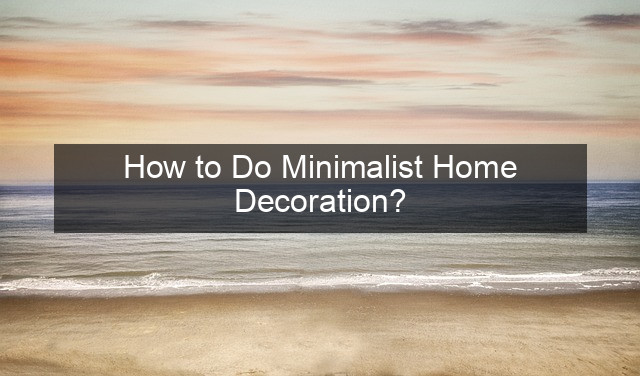How to Do Minimalist Home Decoration?

- How to Do Minimalist Home Decoration?
- Embracing Minimalist Home Decor: A Guide to Simplicity and Style
- Defining Your Minimalist Style
- Choosing a Color Palette
- Focusing on Functionality
- Decluttering and Organizing
- Maximizing Space and Light
- Embracing Natural Light
- Strategic Furniture Placement
- Utilizing Vertical Storage
- Adding Personality with Minimalist Decor
- Incorporating Texture and Pattern
- Introducing Greenery
- Showcasing Meaningful Objects
- Conclusion
- Frequently Asked Questions
- What is the first step in minimalist decorating?

Embracing Minimalist Home Decor: A Guide to Simplicity and Style
In today’s fast-paced world, the allure of a minimalist home is undeniable. It offers a sanctuary from the chaos, a space where tranquility reigns supreme. Minimalist home decoration isn’t just about decluttering; it’s about curating a space that reflects your essence, free from unnecessary distractions. It’s about embracing simplicity and celebrating functionality. Minimalist home decor promotes a sense of calm and order, allowing you to focus on what truly matters. This comprehensive guide will delve into the art of minimalist home decorating, offering practical tips and insightful advice to transform your space into a haven of peace and style.
This approach goes beyond mere aesthetics. It’s a lifestyle choice that prioritizes intentionality and mindful consumption. By carefully selecting each item that graces your home, you create an environment that resonates with your values. This journey towards minimalism is personal and evolving, allowing you to discover the true meaning of “less is more.” It’s about creating a space that breathes, a space that nourishes your soul, and a space that truly feels like home.
Defining Your Minimalist Style
Choosing a Color Palette
The foundation of any minimalist space lies in its color scheme. Opt for a neutral palette of whites, grays, and beiges to create a sense of spaciousness and serenity. These colors act as a blank canvas, allowing your carefully chosen furnishings and decor to stand out. Consider incorporating subtle variations within your chosen hues to add depth and visual interest.
Introducing pops of color strategically can inject personality without overwhelming the space. A vibrant piece of artwork, a colorful throw pillow, or a single statement chair can add a touch of individuality. Remember, the key is to maintain balance and restraint.
Think about the natural light in your space and how different colors will interact with it. A north-facing room might benefit from warmer tones, while a south-facing room can handle cooler shades. Experiment with paint samples and fabric swatches to find the perfect palette for your home.
Focusing on Functionality
Every item in a minimalist home should serve a purpose. Avoid clutter by carefully considering the functionality of each piece before introducing it into your space. Choose furniture that is both aesthetically pleasing and practical. Multi-purpose furniture, such as storage ottomans or sofa beds, can be invaluable in maximizing space and minimizing clutter.
Invest in high-quality, durable pieces that will stand the test of time. This approach not only reduces waste but also ensures that your home is filled with items you truly love and appreciate. Prioritize functionality over fleeting trends to create a timeless and enduring minimalist aesthetic.
When selecting furniture, consider its scale and proportion in relation to the size of your room. Oversized furniture can make a space feel cramped, while undersized pieces can appear lost. Strive for a balanced and harmonious arrangement that promotes flow and functionality.
Decluttering and Organizing
Decluttering is an essential step in achieving a minimalist aesthetic. Start by systematically going through each room and removing anything that doesn’t serve a purpose or bring you joy. Donate, sell, or recycle unwanted items to free up space and create a sense of clarity.
Once you’ve decluttered, focus on organizing the remaining items. Invest in smart storage solutions to keep your belongings tidy and out of sight. Utilize drawers, shelves, and baskets to maximize storage space and maintain a clutter-free environment.
Regularly reassess your belongings and declutter as needed. Minimalism is an ongoing process, and it’s important to stay vigilant in maintaining a clutter-free space. By consistently decluttering and organizing, you can create a home that feels calm, inviting, and truly minimalist.
Maximizing Space and Light
Embracing Natural Light
Natural light is a cornerstone of minimalist design. Maximize natural light by keeping windows unobstructed and using sheer curtains or blinds to filter light without blocking it entirely. Mirrors can also be strategically placed to reflect light and create an illusion of spaciousness.
Consider the orientation of your home and how natural light changes throughout the day. Adjust your lighting accordingly to create a warm and inviting atmosphere. Embrace the natural beauty of light and shadow to enhance the minimalist aesthetic.
Avoid heavy drapes and dark window treatments, which can absorb light and make a room feel smaller. Opt for light and airy window coverings that allow natural light to flood the space, creating a bright and cheerful ambiance.
Strategic Furniture Placement
The placement of furniture plays a crucial role in maximizing space and creating a sense of flow. Avoid overcrowding a room by carefully selecting and positioning furniture pieces. Leave ample space between furniture to allow for easy movement and create a sense of airiness.
Consider the function of each room and arrange furniture accordingly. Create designated areas for specific activities, such as reading, working, or relaxing. This intentional approach to furniture placement enhances functionality and promotes a sense of order.
Think about the traffic flow in your home and arrange furniture in a way that facilitates movement. Avoid placing furniture in pathways or creating obstacles that disrupt the natural flow of the space.
Utilizing Vertical Storage
Vertical storage is a valuable tool in maximizing space, especially in smaller homes. Utilize tall bookshelves, wall-mounted shelves, and vertical storage units to keep belongings organized and out of sight. This approach frees up valuable floor space and creates a more open and airy feel.
Think creatively about how you can utilize vertical space. Install shelves above doorways or windows, or use wall-mounted organizers to store items that would otherwise clutter countertops or floors.
Choose storage solutions that complement your minimalist aesthetic. Opt for clean lines, simple designs, and neutral colors to maintain a cohesive and uncluttered look.
Adding Personality with Minimalist Decor
Incorporating Texture and Pattern
While minimalism often emphasizes solid colors, incorporating texture and pattern can add visual interest and warmth without overwhelming the space. Introduce texture through natural materials such as wood, linen, and wool. Subtle patterns can also be incorporated through textiles, rugs, or artwork.
Choose textures and patterns that complement your overall color palette and style. Avoid overly busy patterns or clashing textures, which can detract from the minimalist aesthetic. Strive for a harmonious balance of texture and pattern to create a visually appealing and inviting space.
Consider the scale of the patterns you choose. Larger patterns can make a statement, while smaller, more subtle patterns can add depth and interest without overwhelming the space.
Introducing Greenery
Plants add life and vibrancy to any minimalist space. Introduce greenery through strategically placed potted plants, hanging planters, or fresh-cut flowers. Plants not only enhance the aesthetic appeal of your home but also improve air quality and create a sense of tranquility.
Choose plants that thrive in your home’s lighting conditions and require minimal maintenance. Succulents, snake plants, and ZZ plants are excellent choices for low-maintenance greenery.
Consider the size and scale of your plants in relation to the space. Larger plants can make a bold statement, while smaller plants can be grouped together to create a visually appealing display.
Showcasing Meaningful Objects
Minimalism isn’t about living in a sterile or impersonal space. Incorporate meaningful objects that reflect your personality and tell your story. Display cherished photographs, travel souvenirs, or artwork that evokes positive emotions.
Choose a few carefully selected items to display rather than cluttering surfaces with numerous objects. This curated approach allows each item to stand out and be appreciated.
Consider the placement of your meaningful objects. Arrange them in a way that creates a focal point or adds visual interest to a specific area.
Conclusion
Creating a minimalist home is a journey, not a destination. It’s about consciously choosing what to bring into your space and appreciating the beauty of simplicity. By decluttering, organizing, and focusing on functionality, you can create a home that promotes tranquility and reflects your personal style.
Remember, minimalist home decor is not about deprivation, but about intentionality. It’s about surrounding yourself with items that bring you joy and contribute to a sense of calm and order. Embrace the process, experiment with different approaches, and discover the transformative power of minimalist living.
As you continue to refine your minimalist aesthetic, remember that it’s a constantly evolving process. Regularly reassess your belongings, declutter as needed, and adjust your decor to reflect your changing needs and preferences. The ultimate goal is to create a space that feels authentically you, a space that nourishes your soul and supports your well-being.




